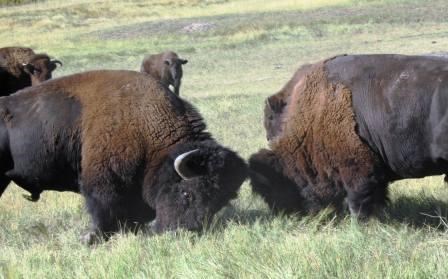
NPS Photo - Wind Cave National Park Emergencies: dial 911 Know before you go:Safety Essentials
TravelingWatch out for traffic, pedestrians, and road conditions in the Flint Hills. Wildlife cross the road frequently. Use caution navigating the curves and blind hills, especially at night. Heavy semi-trucks and slow farm equipment are not uncommon. The Visitor Center is 3 miles north of Strong City via KS-177, a 60 mph highway with no shoulder. KS-177 has light to moderate traffic with semi-trucks.
Downtown Strong City is 1 mile from the Bottomland Nature Trail parking area. The underpass from the west end of Sixth Street and Pine Street provides safer travel. County road 227 is a 30 mph gravel road with light, mostly local traffic.
The Visitor Center is off K-177. The 60 mph highway has no shoulder, sloped drainage, blind hills, and infrequent driveways. Visitors are discouraged from parking or walking along the highway. K-177 recieves moderate semi traffic through the day and low traffic at night. Hiking TrailsTrails are open 24/7. Stay on established trails when possible. The trails remain the clearest spot to see wildlife and reduce negative wildlife encounters. Know the trail difficulty before setting out. Tall vegetation and rocky landscape make off-trail ventures hazardous. Nature trails cover the bottomlands close to parking areas. Backcountry trails go further into the uplands. Practice Leave No Trace principles. Wildfires naturally occur on the Great Plains throughout the year. Prescribed burns in the Flint Hills are common in the early spring and fall. Smoke may affect the air quality for several miles. Preserve employees close all nearby trails before a prescribed burn on the property. Due to the flame speed, fuels, and weather, fires may spread faster than visitors can safely respond. Please obey all closure signs. Pets are permitted around the visitor center, historic ranch area, and Nature Trails. Read more pet tips while visiting to the preserve.
Leaves of three, let it be! Poison ivy is found throughout the preserve. It is not an invasive exotic plant, but rather a native component of the plant community. It thrives in areas of disturbance, such as along the creeks and shaded groves. Berries from the plant are a highly nutritious food for birds and animals. The vine provides cover and protects the soil from erosion. As a native plant, poison ivy is protected in most places in the park. We do manage poison ivy along the trails. Please use caution while in the park and keep an eye on your children and pets. Contact with poison ivy:
Weather can be unpredictable on the Great Plains. The prairie provides little cover from the elements. Thunderstorms and high winds are not uncommon. Most grass trails become slippery with mud after a short rain. Tornados and wild fires are rare, but dangerous in the open grassland. Check our current weather for safety measures you may take while visiting to the preserve.
WildlifeAnimals on the preserve are wild and unpredictable. Don't let the large bison distract you. The preserve thrives with several smaller creatures. Ticks, chiggers, and mosquitoes actively look for a summer meal. Check out the Animal Lists found at the preserve.
The preserve's bison occupy Windmill Pasture and sometimes West Traps Pasture. Signs are posted on all trail gates entering bison areas. Bison often appear docile but will attack when threatened. Bison become more aggressive in the spring birthing and the fall breeding seasons.
A few venomous snakes live on the preserve including the massasauga rattlesnake and copperhead. Snakes are most active in the warm summer between April and October. On occasion, snakes have been seen inside the historic buildings.
Bites
Sources: Mayo Clinic, Focus Medica (Nov 2021) Ticks & chiggers are mostly active late spring to early fall on the prairie. Tick-borne diseases are an increasing public health concern across the region. To limit your exposure:
Learn more from the Centers for Disease Control and Prevention. |
Last updated: September 11, 2024
